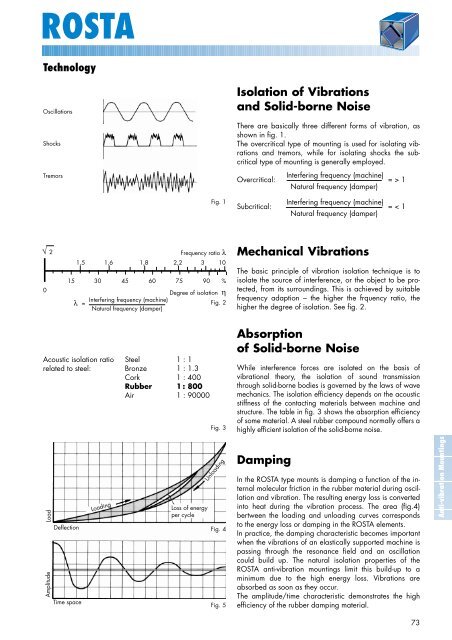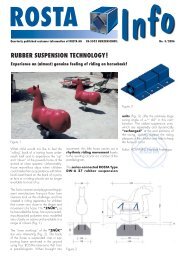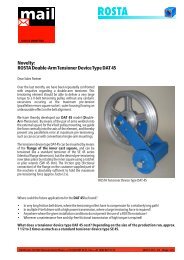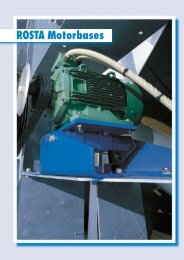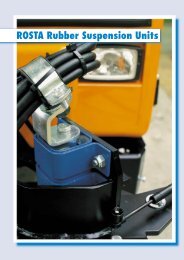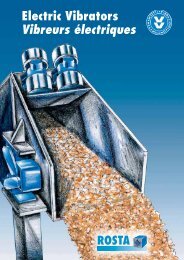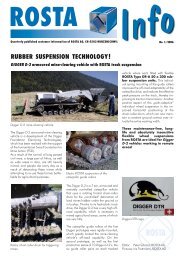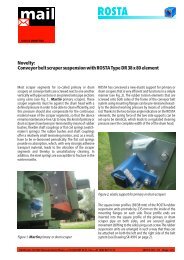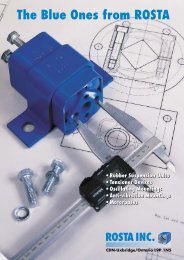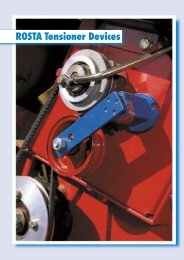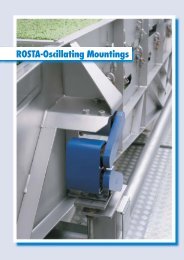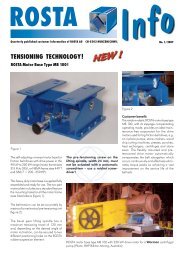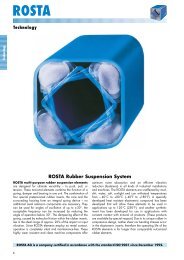ROSTA Anti-vibration Mountings - ROSTA Inc.
ROSTA Anti-vibration Mountings - ROSTA Inc.
ROSTA Anti-vibration Mountings - ROSTA Inc.
You also want an ePaper? Increase the reach of your titles
YUMPU automatically turns print PDFs into web optimized ePapers that Google loves.
<strong>ROSTA</strong><br />
Technology<br />
Oscillations<br />
Shocks<br />
Isolation of Vibrations<br />
and Solid-borne Noise<br />
There are basically three different forms of <strong>vibration</strong>, as<br />
shown in fig. 1.<br />
The overcritical type of mounting is used for isolating <strong>vibration</strong>s<br />
and tremors, while for isolating shocks the subcritical<br />
type of mounting is generally employed.<br />
Tremors<br />
Overcritical:<br />
Interfering frequency (machine)<br />
Natural frequency (damper)<br />
= > 1<br />
Fig. 1<br />
Subcritical:<br />
Interfering frequency (machine)<br />
Natural frequency (damper)<br />
= < 1<br />
√ 2<br />
0<br />
Frequency ratio λ<br />
1,5 1,6 1,8 2,2 3 10<br />
15 30 45 60 75 90 %<br />
Degree of isolation η<br />
Interfering frequency (machine)<br />
λ = Fig. 2<br />
Natural frequency (damper)<br />
Mechanical Vibrations<br />
The basic principle of <strong>vibration</strong> isolation technique is to<br />
isolate the source of interference, or the object to be protected,<br />
from its surroundings. This is achieved by suitable<br />
frequency adaption – the higher the frquency ratio, the<br />
higher the degree of isolation. See fig. 2.<br />
Acoustic isolation ratio Steel 1 : 1<br />
related to steel: Bronze 1 : 1.3<br />
Cork 1 : 400<br />
Rubber 1 : 800<br />
Air 1 : 90000<br />
Fig. 3<br />
Absorption<br />
of Solid-borne Noise<br />
While interference forces are isolated on the basis of<br />
<strong>vibration</strong>al theory, the isolation of sound transmission<br />
through solid-borne bodies is governed by the laws of wave<br />
mechanics. The isolation efficiency depends on the acoustic<br />
stiffness of the contacting materials between machine and<br />
structure. The table in fig. 3 shows the absorption efficiency<br />
of some material. A steel rubber compound normally offers a<br />
highly efficient isolation of the solid-borne noise.<br />
Amplitude Load<br />
Deflection<br />
Time space<br />
Loading<br />
Loss of energy<br />
per cycle<br />
Unloading<br />
Fig. 4<br />
Fig. 5<br />
Damping<br />
In the <strong>ROSTA</strong> type mounts is damping a function of the internal<br />
molecular friction in the rubber material during oscillation<br />
and <strong>vibration</strong>. The resulting energy loss is converted<br />
into heat during the <strong>vibration</strong> process. The area (fig.4)<br />
bertween the loading and unloading curves corresponds<br />
to the energy loss or damping in the <strong>ROSTA</strong> elements.<br />
In practice, the damping characteristic becomes important<br />
when the <strong>vibration</strong>s of an elastically supported machine is<br />
passing through the resonance field and an oscillation<br />
could build up. The natural isolation properties of the<br />
<strong>ROSTA</strong> anti-<strong>vibration</strong> mountings limit this build-up to a<br />
minimum due to the high energy loss. Vibrations are<br />
absorbed as soon as they occur.<br />
The amplitude/time characteristic demonstrates the high<br />
efficiency of the rubber damping material.<br />
<strong>Anti</strong>-<strong>vibration</strong> <strong>Mountings</strong><br />
73


